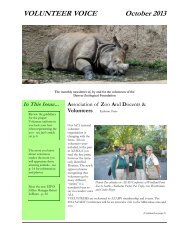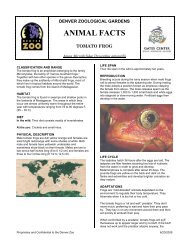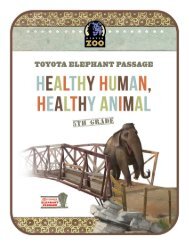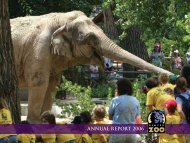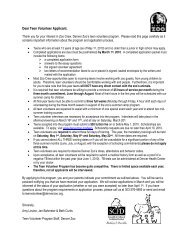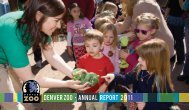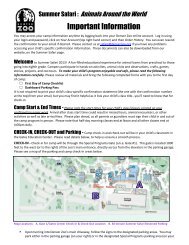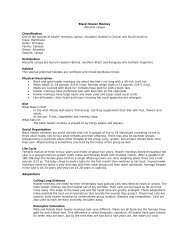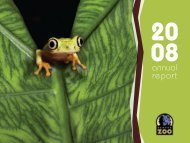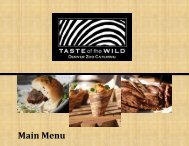Dear Friends - Denver Zoo
Dear Friends - Denver Zoo
Dear Friends - Denver Zoo
- No tags were found...
You also want an ePaper? Increase the reach of your titles
YUMPU automatically turns print PDFs into web optimized ePapers that Google loves.
<strong>Dear</strong> <strong>Friends</strong>:DENVER ZOOLOGICAL FOUNDATION, INC.2300 STEELE STREETDENVER, COLORADO 80205-4899WEBSITEwww.denverzoo.orgZOO INFORMATION720.337.1400In cooperation with theCity and County of <strong>Denver</strong>ACCREDITED BY THEPRINTING BYWelcome to a special publication celebrating the next major milestone in <strong>Denver</strong> <strong>Zoo</strong>’s 116-year history, ToyotaElephant Passage. The outpouring of support for Toyota Elephant Passage has been phenomenal. We wouldlike to thank everyone who has supported this incredible endeavor. In 1999, the voters of <strong>Denver</strong> approved zooimprovement bond funds that provided 50 percent of the funding for Toyota Elephant Passage. This project wouldnot be possible without the support of the citizens of <strong>Denver</strong>. With more than 3,000 donors to the project, it is trulyamazing how many gifts we received from our staff, volunteers, members, children and the community as a whole tohelp us exceed our $50 million campaign goal. We are especially grateful for the generous support and commitmentof our naming sponsor, the <strong>Denver</strong> Toyota Dealers Association, and other major supporters, including The AnschutzFoundation, El Pomar Foundation and the Monfort Family Foundation. We are very fortunate to live in a communitywhere so many people share our vision for conserving wildlife and ecosystems.Nearly nine years in the making from initial design to opening, our new home for elephants Mimi and Dolly, along withmany new animal friends, is unlike any other zoo experience. In a few short weeks, you’ll find yourselves surroundedby elephants, rhinos and tapirs exploring a network of six interconnected habitats; experience gibbons swingingdirectly overhead; share space with fruit bats; and be mesmerized by fishing cats showing off their angling expertise.These and a host of other engaging Toyota Elephant Passage experiences are truly fun with an important purpose.I’m often asked why Toyota Elephant Passage is so vital. I firmly believe it’s fundamental to fulfilling <strong>Denver</strong> <strong>Zoo</strong>’smission to secure a better world for animals through human understanding. During my zoo career, the wildAsian elephant population has plummeted from more than 100,000 to less than 35,000 – an alarming loss in justa few short decades. If we don’t do something bold, elephants could well become extinct in this century. <strong>Denver</strong><strong>Zoo</strong> will not sit idly by and allow these incredible animals to disappear forever. If we can’t mobilize to save one of theworld’s most beloved animals, what’s the prospect for thousands of other less-charismatic, yet equally preciousendangered species as well as ourselves? That’s why we developed Toyota Elephant Passage to advance elephantconservation in a number of ways. This exhibit will serve as an important center in collaborative zoo efforts tocreate a stable insurance population of elephants in human care. It also provides unparalleled habitats that giveanimals a great deal of variety and choice in their day, coupled with engaging guest experiences designed to help ussee animals in completely novel ways. The exhibit shares compellingstories about the challenges faced by animals and people in tropicalAsia and innovative strategies by <strong>Denver</strong> <strong>Zoo</strong> staff and colleaguesto resolve conflicts and help both. Lastly, thanks to the tremendousefforts of every <strong>Denver</strong> <strong>Zoo</strong> staff member, led by our talented PlanningDepartment, Toyota Elephant Passage will undoubtedly be the mostsustainable zoo facility in the world and will mark a major step inour goal to be a zero-waste institution by 2025. As a conservationorganization, we simply must be a model for how people can live, workand thrive with a lighter touch on our planet.I hope you’ll enjoy the stories that detail the animals and people whomake Toyota Elephant Passage an experience that will be differentevery time you visit. You’ll also find important information on how youcan be one of the first to be welcomed by Mimi and Dolly in their newhome at our exclusive sneak peeks. I look forward to sharing ToyotaElephant Passage with you. I’m sure you’ll find it tobe fun with a purpose.Craig PiperPresident/CEO- 1 -
Toyota Elephant Passage Tells the Stories ofTropical AsiaNearly a decade of planning, two years of constructionand more than $50 million in fundraising will bring ToyotaElephant Passage to life. The result will be an immersiveexhibit that will showcase the zoo’s mission to secure abetter world for animals through human understanding,like no previous exhibit ever has before.“Toyota Elephant Passage will tell the stories of animals,places and people throughout various regions in tropicalAsia. These are stories we have witnessed firsthand thathelp people understand the complex relationships betweenanimals and people that make conservation such a criticalneed in this area,” explains Director of Public ProgramsBrad Parks.Parks is one of several zoo staffers who regularly travelsto Asia to support animal conservation in the continent’stropical regions. The zoo currently has projects in Sumatra,Indonesia, Thailand, Malaysia, Sri Lanka, Nepal andVietnam. Although Parks’ particular area of focus is inVietnam, the conservation approach throughout tropicalAsia is the same – you must help people in order to saveanimals.“Human encroachment and competition for resourcescause conflicts between animals and people. To help speciesfacing these threats, we must understand the root cause ofthese conflicts and work with the local people to create realsolutions to these difficult problems,” says Vice Presidentfor Conservation Biology Dr. Rich Reading.Guests will see this conflict in an area of the exhibit calledthe Village Outpost that depicts a rural village strugglingto co-exist with elephants. Damaged huts and cropswill impart a profound message about how elephantdestruction can affect local residents’ livelihoods. In thisparticular area, residents have fled after elephants haveknocked down walls and ravaged their crops.Toyota Elephant Passage will bring these conservationissues to life and illustrate the efforts that <strong>Denver</strong> <strong>Zoo</strong> istaking to ensure the wellbeing of animals both in the wildand in the zoo’s care.The exhibit also celebrates the rich cultural connectionsof Asian people with wildlife. The Schoelzel FamilyVillage will be a lively hub in Toyota Elephant Passagewith opportunities to explore a local market and discoverHindu and Buddhist traditions connecting peoplewith animals. Schoelzel Family Village also includesthe Clayton Freiheit Elephant House and the El PomarFoundation Village Hall that will house flying fox, fishingcat and Asian small clawed otters.On the west end of Toyota Elephant Passage, guestswill view animals free of visible barriers in the ChangPa Wildlife Preserve. Here, gibbons will swing directlyoverhead as they move between three island habitatsabove a guest boardwalk. This area will demonstratethe importance of protecting places for wildlife and howanimals are managed in protected areas of Southeast Asia.The species in the exhibit will serve as ambassadorsfor their cousins in the wild and will aid in showing theways <strong>Denver</strong> <strong>Zoo</strong> is working to help people and animalspeacefully coexist. With these three distinctly definedregions, Toyota Elephant Passage will bring the storiesof the varied animals, people and cultures vividly to lifeand inspire all who visit to further appreciate and supportwildlife from these areas.“This is a very real scenario for farmers who are trying togrow crops where wild elephants are trying to find food.Unfortunately, on one of my conservation trips I saw thelocal people hold a funeral for an elephant that was killedfor invading the village. These are good people who weresaddened at the death of this majestic animal. Althoughelephants are revered in this culture, these people felt thiswas the only way to stop what was happening,” recountsDale Leeds, Curator of Toyota Elephant Passage.- 3 -
Meet thecaretakersof toyota Elephant PassageToyota Elephant Passage“LEED”s InSustainabilityCurator Dale Leeds and Area Supervisor Becca McCloskeyare the managers of the 15 staff members who provide thedaily care for the animals inside Toyota Elephant Passage.Dale came to <strong>Denver</strong> <strong>Zoo</strong> in 1998 as Curator of LargeMammals. His previous experience ushering in theaward-winning Predator Ridge exhibit for African animalsin 2004, coupled with more than 20 years workingwith elephants, made him the ideal candidate for theToyota Elephant Passage Curator position. In additionto his expertise in elephant care, Dale is a ProfessionalMember of the Association of <strong>Zoo</strong>s and Aquariums (AZA),Elephant Managers Association and serves on the AZASteering Committee for the Elephant Species SurvivalPlan and Taxon Advisory Group. Since coming to <strong>Denver</strong><strong>Zoo</strong>, Dale has worked on conservation projects to supportelephants in Namibia, Sri Lanka and Vietnam.Becca McCloskey joined <strong>Denver</strong> <strong>Zoo</strong> in 2009 as azookeeper in the Large Mammal department, workingwith everything from elephants and rhinos to thecarnivores at Predator Ridge. Previously, she created andmanaged a carnivore department for five years at WildlifeSafari in Winston, Oregon. Becca was promoted to ToyotaElephant Passage Area Supervisor in June of 2011 andworks with Dale to manage the day-to-day operations ofToyota Elephant Passage.Kneeling left to right:Gabe Kibe: pachyderms (2001)Maggie Farr: kansas city zoo (2012)Molly Kainuma: san diego zoo (2012;a former <strong>Denver</strong> <strong>Zoo</strong> primate keeper)Dennis Donovan: commissary (2011)Lisa Parrish: large mammals (2006)Lindsey Kirkman: disney’s animal kingdom (2011)Standing left to right:Becca McCloskey: large mammals (2009)Laura Morrell: predator ridge (2006)Jennifer Hickman: primates (2002)Mike Murray: predator ridge (2009)Barb Junkermeier: pachyderms (1997)Katie Ryan: pachyderms (2010)Dale Leeds: large mammals (1998)Chris Bobko: pachyderms (1990)Matt Lenyo: education (2011)Danielle Lints: central florida zoo (2011)Dave Johnson: pachyderms (1998)There were plenty of places for guests to get a beverage atthe 2011 Do At The <strong>Zoo</strong> gala, but only one that also servedas both a genuine conversation starter and a taxi. In frontof what will eventually be the entrance to Toyota ElephantPassage, <strong>Denver</strong> <strong>Zoo</strong>’s Planning Department staff mixedmargaritas on the back of a blue, three-wheeled tuk tuk, ormotorized rickshaw. What really caused a stir though, wasthe sustainable system behind the salty spirits.“This thing’s run on what?” asked a somewhat surprisedwoman in a black-and-white cocktail dress.“Our trash,” replied the zoo employee as he calmly flickedon the blender.Call it “applied science” or maybe a relaxing way ofdemonstrating the innovativeness of Toyota ElephantPassage. The tuk tuk, and its margarita maker, werepowered by a miniature version of the exhibit’s biomassgasification system, or gasifier, which will convert the zoo’sdiverse waste stream of animal waste and human trashinto a usable energy. The technological breakthrough willsupport the zoo’s efforts to reduce its landfill contributionsby more than 90 percent, eliminating 1.5 million poundsof trash currently going to landfills annually and reducingenergy and waste-hauling costs by $150,000 a year,putting the zoo a giant step closer to becoming a “zerowaste”facility.The zoo’s innovative sustainability efforts aren’t limitedto zoo applications. The zoo is testing its gasificationtechnology in hopes of becoming a national leader inrenewable energy. Toyota Elephant Passage will be ahighly visible model project in reducing dependency ontraditional energy resources as well as reducing challengesin managing solid waste streams. When fully operational,the gasification system is projected to produce 20 percentof the zoo’s total energy needs.Reduction also is one of the main goals for how ToyotaElephant Passage uses water. Despite adding more than1.1 million gallons, for everything from animal pools todrinking water, the zoo is actually dropping its overallwater usage. This is mostly thanks to a state-of-the-artfiltration system. In fact, 900,000 gallons in the exhibitalone will be re-circulated through the water filtrationbuilding to be reused. These improvements, as well asdecreasing the amount of irrigation and installing xeriscapevegetation, continue a trend the zoo started more than adecade ago when it began reducing its annual water usagefrom 340 million gallons to about 170 million gallons in2007. Hale says she hopes this inspires zoo guests to makechanges in their own backyards.<strong>Denver</strong> <strong>Zoo</strong>’s Toyota Elephant Passage team hasextensive experience caring for the diverse collection ofanimals who call the exhibit home. Here are our ToyotaElephant Passage keepers, together with their formerresponsibilities/locations before moving to the newexhibit and the year they joined <strong>Denver</strong> <strong>Zoo</strong>. Collectively,including Dale and Becca, they bring more than 200 yearsof animal care experience.“I think people are really excited when they make theconnection that waste can equal energy,” says SustainabilityManager Jennifer Hale. “It gets them thinking of not onlybetter ways to use waste, but also the idea of ‘pre-cycling,’looking at the things they buy and use to see if they caneventually be recycled so they don’t end up in a landfill.”- 15 -
“LEED”s continuedHere are just a few examples of sustainable practices utilized in ToyotaElephant Passage that will aid our effort to gain LEED Certification.“Water is a precious resource for us in Colorado, and it’simportant for us to conserve all the water we can,” saysHale. “Many of us have lawns or gardens, and there aretools available to help conserve water and still maintainhealthy landscaping.”Hale says that “leadership by example” mentality is a bigpart of why the zoo is seeking LEED ® certification forToyota Elephant Passage at the platinum level, the highestlevel, from the U.S. Green Building Council. The programrecognizes sustainable and green building practices.In addition to its gasification and water-use methods,<strong>Denver</strong> <strong>Zoo</strong> hopes to achieve the status with its use ofnatural daylight and ventilation, efficient heating andcooling systems, and other green design and constructionpractices. Hale says the certification would demonstrateto the business and construction communities that zoos,aquariums and other facilities can be green leaders.Vice President for Planning and Capital Projects GeorgePond has championed the zoo’s leadership in sustainabilityand says Toyota Elephant Passage is just the beginning ofwhat the zoo can accomplish.“This certification is only for these 10 acres and 10 buildings.What gets really exciting is planning for the future,” saysPond. “How can we apply what we’ve accomplished atToyota Elephant Passage elsewhere? We can keep pushingthe envelope.”The zoo continues to push that envelope – one alreadyfull of potential and recognition. Inaugural winner ofthe Association of <strong>Zoo</strong>s and Aquariums Green Award,WateReuse Customer of the Year and Bicycle FriendlyBusiness Award are just a few of the most recent accoladesfor the zoo. All of these honors came after its internationalcertification for sustainable management, called ISO-14001, a process that commits the zoo to benchmarking itsprogress on sustainability in all of its operations to ensurecontinued improvement. <strong>Denver</strong> <strong>Zoo</strong> is the first Americanzoo to achieve this certification.“Toyota Elephant Passage propels us leaps and boundstoward achieving our sustainable goals. In many ways,the development of this exhibit has helped us become thegreenest zoo in the country,” says Pond.Biomass Gasification SystemOne of the most intriguing additions to Toyota ElephantPassage turns human trash and animal waste into energy.The gasification system will convert more than 90 percentof the zoo’s waste into usable energy to power the exhibit,eliminating 1.5 million pounds of trash currently going tolandfills annually.Wise Water UseA state-of-the-art water filtration system recycles mostof the 1.1 million gallons of water running throughToyota Elephant Passage. <strong>Denver</strong> <strong>Zoo</strong> also decreasesirrigation and installs xeriscape vegetation to lessenoverall water demand.Natural DaylightNatural light through sky lights and windows decreaseselectric lighting use throughout the interior buildings of theexhibit. Six zoo buildings utilize Solatube ® , an innovativesystem that reflects sunlight to provide natural, clean lightinto a space. Plus, UV rays drawn from natural daylight areimportant to the health of our animal collection.Radiant HeatingRadiant-heated floor systems retain heat at lower elevationsof a room longer than traditional HVAC systems. They willlast the life of the building without requiring maintenance,and save energy, money and time for repairs. They will alsobe used in several outdoor spaces, providing a safe walkingenvironment for guests and animals during winter months.VentilationExtra ventilation was installed to improve indoor airquality. Monitoring systems sound an alarm when airconditions or temperatures vary by 10 percent. All carpets,paints, coatings and adhesives used in Toyota ElephantPassage are low in VOCs (volatile organic compounds),making them better for human and animal health as wellas the environment.Independent SystemsLighting, heating and cooling systems will be controlledindependently. This allows a worker to turn on a task lightin a specific area rather than having to turn on lights to anentire building.Sunlight ReflectionRoofs and hardscapes were installed with light colors tohelp reflect sunlight, which reduces cooling costs.- 17 -
Neighborhood ToyotaStores Make ExhibitPossibleTeamwork to DevelopExhibit Brings Missionand Vision to Life“Toyota Elephant Passage had an impact on <strong>Denver</strong> <strong>Zoo</strong>unlike anything else. It has changed us.”Toyota Elephant Passage was made possible by thegenerous support of your <strong>Denver</strong> neighborhood Toyotastores. Seven Toyota dealerships in the <strong>Denver</strong>metro,Boulder and Frederick areas awarded the zooa multimillion dollar sponsorship, bringing the totaldollar amount raised for the exhibit to $50 million. Thesponsorship support from Toyota completed the campaignto raise private matching funds for the <strong>Zoo</strong> ImprovementBond program.“The <strong>Denver</strong> Toyota Dealers Association is thrilled topartner with <strong>Denver</strong> <strong>Zoo</strong> for Toyota Elephant Passage. Ourseven Neighborhood Toyota stores strive to enhance thecommunities where we live and work,” shares Go ToyotaGeneral Manager and <strong>Denver</strong> Toyota Dealers Associationspokesman, Jeff Thorpe.“We’re excited to partner with our neighborhood Toyotastores. Each of them has a strong commitment to thecommunity and supports <strong>Denver</strong> <strong>Zoo</strong>’s efforts toprovide outstanding family experiences and educationalopportunities with every zoo visit. We look forward to theyears ahead when our teams will work together to help bothpeople and animals through this exciting partnership,” says<strong>Denver</strong> <strong>Zoo</strong> President/CEO Craig Piper.Piper additionally notes that “Toyota’s commitment toprotecting the environment through their own operationsand innovative products, like hybrid synergy drivetechnology, makes them a great fit with <strong>Denver</strong> <strong>Zoo</strong>’scutting-edge work in global conservation and sustainablebusiness practices.”The Neighborhood Toyota Stores supporting ToyotaElephant Passage include: Groove Toyota in Englewood,Mountain States Toyota in <strong>Denver</strong>, Stapp InterstateToyota in Frederick, Stevinson Toyota East in Aurora,Stevinson Toyota West in Lakewood, Larry H. MillerToyota in Boulder and Go Toyota in Centennial.Photo cutline: From left, Scott Allan, Toyota Motor Sales <strong>Denver</strong> Region; Michael Keller, Toyota Motor Sales <strong>Denver</strong> Region; Jeff Thorpe, General Manager, Go Toyota; DeckHughes, General Manager, Stevinson Toyota West; Rob Edwards, General Manager, Groove Toyota; Brion Stapp, Dealer Principal, Stapp Interstate Toyota; Tim Van Binsbergen,General Manager, Mountain States Toyota; Steve Doersam, General Manager, Larry H. Miller Toyota Boulder; Kent Stevinson, President, Stevinson Automotive Inc.That’s a quote that can’t be attributed to any oneemployee, but one that was echoed by many throughoutthe development of the project. The immensely timeconsuming,detailed and, at intervals, painstaking processof developing an exhibit that championed the zoo’s missionand core values brought zoo staff together like no otherexhibit had before.“Our zoo is filled with intelligent and dedicatedemployees, and we sought their expertise andsupport. With something this big, we needed helpand buy-in from every staff member. Often it wasmessy and complicated, but it needed to be. Itwas a reflection of our dedication to teamwork,quality and innovation,” explains the head ofthe Planning Department, Vice President forPlanning and Capital Projects George Pond.The process of planning the new exhibit started more thaneight years before its opening and was led by the zoo’sambitious Planning Department. The development ofthe project grew to include staff from all areas of the zoo.Teams from all departments ultimately were brought in towork out the myriad details necessary to open and operatethe zoo’s largest and most ambitious project in its history.The result is a new culture that has raised the bar for all of<strong>Denver</strong> <strong>Zoo</strong>’s efforts.“We can’t thank enough those who committed their timeto this. What we’ve done as a team is truly amazing,” saysDirector of Marketing Patrick Phelan. With Pond, Phelanand Director of Communications Tiffany Barnhart led thecore committee for the opening of Toyota ElephantPassage. Ultimately, the core committee grew to a teamof 17 people who managed 10 subcommittees of nearly 100staff members.“There were a lot of days we had breakfast, lunch and dinnermeetings all in the same day to make sure we were staying ontask. It was crazy busy. We would be remiss if we didn’t alsothank all the spouses and pizza delivery people that helpedmake this happen,” jokes Barnhart. “When I look back onit all, I’m just so grateful for the enormous dedication anddetermination of our team.”Although time consuming and difficult, the result ofthis teamwork has paid off by exceeding the goals forthe exhibit.“I am extraordinarily proud of our team’s accomplishmentsin the development of Toyota Elephant Passage. Every timeI walk the construction site, I can see the collective passionand commitment of our talented <strong>Denver</strong> <strong>Zoo</strong> staff,” sharesPresident/CEO Craig Piper. “Their extensive collaborationhas led to numerous innovations that allow us to bothconnect our guests with animals in new ways and better linka zoo experience to our active field conservation programsaround the world.”- 19 -
Toyota Elephant PassageOffers Culinary Delightsat New Kamala Café<strong>Denver</strong> <strong>Zoo</strong> ThanksOur Major Supportersof this ExhibitAt the new Kamala Café, guests can dine al fresco onpan-Asian selections while watching animals participatein demonstrations at the McGrath Family Amphitheater.<strong>Denver</strong> <strong>Zoo</strong>’s food services partner, KM Concessions,developed a menu for the new restaurant that offers avariety of choices with some culinary twists, like using itemsfrom Colorado Proud partners, whose food and agriculturalproducts are grown, raised or processed in Colorado.Menu items include Asian barbecue chicken lettuce wraps,mini Kobe beef sliders on a brioche bun with Asian gingersalt, and pho rice noodle bowls with chili broth and cilantro.Chefs shared the following recipe for Asian barbecuechicken lettuce wraps that builds immense flavor in just10 minutes of prep time.Asian barbecue chickenlettuce wrapseight servingsIngredients:1 tablespoon canola oil1 tablespoon dark sesame oil1 tablespoon rice vinegar1 tablespoon low-sodium soy sauce1 1/2 teaspoon chili garlic sauce1/2 cup Kim’s Asian BBQ sauce(Colorado Proud company)4 (six-ounce) boneless chicken thighs8 Boston lettuce leaves1/2 cup bean sprouts1/2 cup water chestnuts1 lime cut into eight wedges1/2 cup chopped peanutsPreparation:Combine the first six ingredients in a small bowl; stir witha whisk. Marinate the chicken in the mixture for 12 hours.Remove chicken and discard marinade.Place chicken on hot grill or flattop; grill about sixminutes or until chicken is done, turning once. Letstand about five minutes before slicing. Divide chickenevenly on the lettuce leaves; top each leaf with AsianBBQ sauce, one tablespoon sprouts and one tablespoonwater chestnuts. Serve with lime wedge, and garnishwith chopped peanuts.$5,000,000+Neighborhood Toyota StoresGo ToyotaGroove ToyotaLarry H. Miller ToyotaMountain States ToyotaStapp Interstate ToyotaStevinson Toyota EastStevinson Toyota West<strong>Zoo</strong> Improvement Bonds authorizedby the Citizens of <strong>Denver</strong>$1,000,000–4,999,999The Anschutz Foundation2005–2012 Do At The <strong>Zoo</strong> PatronsEl Pomar FoundationMonfort Family Foundation$750,000–999,000Pat and Forrest McGrath EstateGates Family FoundationScott and Katie Schoelzel$500,000–749,999Bardsley FoundationBoettcher FoundationEncana Oil & Gas (USA) Inc.Helen K. and Arthur E. Johnson FoundationKM Concessions, Inc.Koelbel Family FoundationSchlessman Family Foundation, Inc.Elizabeth B. Searle and FamilyThe Wagner Family and Wagner Equipment Co.$250,000–499,999<strong>Denver</strong> <strong>Zoo</strong> Staff and VolunteersThe Family of Haselden Construction$100,00–249,999The Dikeou FamilyEstate of William B. Chenoweth/Mrs. William ChenowethMarie and Buck FredericksonLaurie GalbreathWilliam and Bei-Lee GoldGovernor’s Energy OfficeThe Kenneth King FoundationMcCormick Charitable Trust/Mary Pat and Richard McCormickBruce and Nancy McGrathAnabel C. and Jerome P. McHughSally and Mark MurrayBetty RobertsonMr. and Mrs. Edward A. RobinsonGeri and Meyer M. SaltzmanTerry and Linda StevinsonWells Fargo$50,000–99,999Anonymous (3)Brownstein Hyatt Farber Schreck, LLPThe Eisinger FamilyClayton F. FreiheitThe Jerry Gart Family FoundationRebecca and Ken GartMarybelle L. Iliff EstateBrian and Cyndy KlepingerI. A. O’Shaughnessy FoundationSandra and Richard McCrayDr. and Mrs. James S. Ogsbury IIIDr. and Mrs. Osgoode S. Philpott, Jr.Cam and Ann PhilpottPioneer Natural ResourcesWalter S. Rosenberry III Charitable TrustCharles and Karen ScogginTerry and Linda StevinsonTricord FoundationHarry L. Willett Foundation$25,000–49,999Lyne and Michael AndrichAnonymous (3)The Autrey FoundationThe Barbara J. Hartley Fund ofThe <strong>Denver</strong> FoundationMarcy and Bruce BensonBetty and Charles Brega/Brega Family FoundationCity and County of <strong>Denver</strong>, CO –SEED ProgramColorado Garden ShowColorado Health FoundationCross H FoundationThe Duke Family, Maud Duke and Laurieand Ben Duke IIIGooding Family FoundationConnie and Andy GrahamDr. and Mrs. Richard E. HolmanClifford and DeVee LushboughEnid and Crosby Kemper Foundation,UMB Bank, N.A., Corporate TrusteeKatharine and James KurtzJeanne Land FoundationGurnee Munn IIINoah’s Ark FoundationMarilyn and Craig PiperJudy and Rick SchiffBetsy SchutteMartin and Jo Ann SempleRobert and Margueritte TaylorMrs. Jacques W. Zoller



